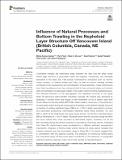Por favor, use este identificador para citar o enlazar a este item:
http://hdl.handle.net/10261/259841COMPARTIR / EXPORTAR:
 SHARE SHARE
 CORE
BASE CORE
BASE
|
|
| Visualizar otros formatos: MARC | Dublin Core | RDF | ORE | MODS | METS | DIDL | DATACITE | |

| Título: | Influence of Natural Processes and Bottom Trawling in the Nepheloid Layer Structure Off Vancouver Island (British Columbia, Canada, NE Pacific) |
Autor: | Arjona-Camas, Marta CSIC ORCID ; Puig, Pere CSIC ORCID ; de Leo, Fabio; Garner, Grant; Paradis Vilar, Sarah CSIC ORCID; Durán, Ruth CSIC ORCID ; Palanques, Albert CSIC ORCID | Palabras clave: | Vancouver Island NE Pacific Upper continental slope NEPTUNE cabled observatory Nepheloid structure Bottom trawling Sediment transport |
Fecha de publicación: | ene-2022 | Editor: | Frontiers Media | Citación: | Frontiers in Marine Science 8: 770280 (2022) | Resumen: | Continental margins are transitional areas between the land and the deep ocean where large amounts of particulate matter are supplied, transported, and ultimately deposited in the deep sea. High-energy hydrodynamic processes such as storms, ocean currents, or internal waves and tides, as well as bottom trawling activities contribute to the resuspension and remobilization of these particles. These mechanisms favor their transference from the continental shelf to the continental slope and maintain high concentrations of particulate matter in the water column forming nepheloid layers. The temporal evolution of the hydrographic and nepheloid structure in the upper slope off Vancouver Island (British Columbia, Canada, NE Pacific) was assessed by analyzing 4 months (from mid-August to late-November 2018) of sensor data from Ocean Networks Canada (ONC) NEPTUNE cabled seafloor observatory. The distribution of particulate matter during the study period illustrated a well-defined turbidity structure consisting of surface nepheloid layers (SNLs) at <100 m depth associated to primary and secondary productivity, intermediate nepheloid layers (INLs) between 150 and 300 m depth at the shelf-break and upper slope domain, and bottom nepheloid layers (BNLs) developed at >400 m depth. Moderate storm events occurred during fall when the more intense INLs were recorded at shelf-break depths. However, not all the INLs recorded during this period occurred in coincidence with these storms, indicating that these INL detachments were modulated by a different sediment resuspension mechanism. Analyses of fishing vessel activity during the study period revealed that trawlers operated over the same depth range as these INLs. Our results suggest that, in combination with the regional currents, the presence of continuous fishing along the continental slope off Vancouver Island contributes to the advection of suspended sediment particles, playing a major role in their transfer as nepheloid layers | Descripción: | 20 pages, 8 figures, 2 tables, supplementary material https://www.frontiersin.org/articles/10.3389/fmars.2021.770280/full#supplementary-material.-- Data Availability Statement: The raw data supporting the conclusions of this article will be made available by the authors, without undue reservation. Data from all the instruments are archived and publicly available online in near-real time via ONC’s Oceans 2.0 Data Management System (https://data.oceannetworks.ca/DataSearch) | Versión del editor: | https://doi.org/10.3389/fmars.2021.770280 | URI: | http://hdl.handle.net/10261/259841 | DOI: | 10.3389/fmars.2021.770280 | E-ISSN: | 2296-7745 |
| Aparece en las colecciones: | (ICM) Artículos |
Ficheros en este ítem:
| Fichero | Descripción | Tamaño | Formato | |
|---|---|---|---|---|
| Arjona_et_al_2022.pdf | 7,97 MB | Adobe PDF |  Visualizar/Abrir | |
| Arjona_et_al_2022_suppl_1.JPEG | 112,29 kB | JPEG |  Visualizar/Abrir | |
| Arjona_et_al_2022_suppl_2.JPEG | 169,38 kB | JPEG |  Visualizar/Abrir | |
| Arjona_et_al_2022_suppl_3.JPEG | 78,59 kB | JPEG |  Visualizar/Abrir |
CORE Recommender
SCOPUSTM
Citations
1
checked on 12-may-2024
WEB OF SCIENCETM
Citations
1
checked on 25-feb-2024
Page view(s)
60
checked on 14-may-2024
Download(s)
117
checked on 14-may-2024
Google ScholarTM
Check
Altmetric
Altmetric
Este item está licenciado bajo una Licencia Creative Commons

